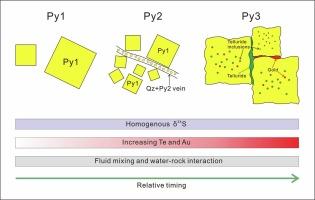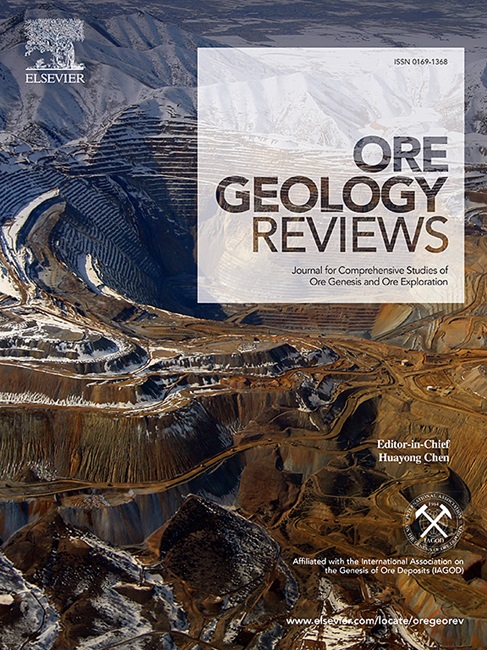Anomalous tellurium enrichment associated with gold mineralization: A mineralogical and isotopic study of the Yongxin Te-Au deposit, northeast China
IF 3.2
2区 地球科学
Q1 GEOLOGY
引用次数: 0
Abstract
The Yongxin tellurium-gold (Te-Au) deposit, a large epithermal deposit in the Duobaoshan polymetallic metallogenic belt (DPMB) within eastern section of the Central Asian Orogenic Belt (CAOB), is mainly hosted by syenogranite and mylonite. However, the Te-Au occurrence, precipitation mechanism and genesis in this deposit remain elusive. In this study, pyrite, the primary host of Te-Au mineralization, was studied utilizing multiparametric techniques such as scanning electron microscope (SEM), electron probe microanalysis (EPMA), in-situ laser ablation-inductively coupled plasma mass spectrometry (LA-ICP-MS) and femtosecond laser ablation coupled multi-collector inductively coupled plasma mass spectrometry (fs LA-MC-ICP-MS). The results show that there are three generations of pyrite termed here as Py1, Py2 and Py3. The coarse euhedral Py1 and fine vein Py2 contain negligible to low contents of Te and Au, whereas the anhedral aggregated Py3 with porosity and grain boundary (GB) shows the highest concentrations of Te and Au. Representative LA-ICP-MS profiles show that Te-Au occurs either as solid solution in the Py1 and Py2 or submicroscopic Au-Ag-Te-Bi inclusions, electrum and native gold in Py3. Thermodynamic data of telluride and sulfide show that the Te-Au was deposited under relatively oxidizing conditions with values of log f Te2 ranging from −15.2 to −11.2 and log f S2 from −16.7 to −12.1. at 200 °C. We infer that fluid mixing and fluid-rock interaction were the dominant mechanisms that triggered the precipitation of Te-Au in the Yongxin Te-Au deposit. Geochemical and geochronological data indicate that the likely source of Te is Te-rich oceanic sediments originating from the Western Pacific Plate. Pyrite and telluride from the gold deposits can be potential targets for Te exploration in the DPMB.

与金矿化有关的异常碲富集:中国东北永新碲金矿床的矿物学和同位素研究
永新碲金(Te-Au)矿床是中亚造山带东段多宝山多金属成矿带中的一个大型热液矿床,主要赋存于正长花岗岩和麦饭石中。然而,该矿床中 Te-Au 的赋存、沉淀机制和成因仍然难以捉摸。本研究利用扫描电子显微镜(SEM)、电子探针显微分析(EPMA)、原位激光烧蚀-电感耦合等离子体质谱(LA-ICP-MS)和飞秒激光烧蚀耦合多收集器电感耦合等离子体质谱(fs LA-MC-ICP-MS)等多参数技术,对碲金矿化的主要寄主黄铁矿进行了研究。结果表明,黄铁矿分为三代,在此分别称为 Py1、Py2 和 Py3。粗八面体 Py1 和细脉 Py2 的 Te 和 Au 含量可忽略不计或很低,而具有多孔性和晶界(GB)的无正面体聚集 Py3 的 Te 和 Au 含量最高。具有代表性的 LA-ICP-MS 图谱显示,Te-Au 在 Py1 和 Py2 中以固溶体形式存在,而在 Py3 中则以亚显微金-银-碲-铋包裹体、电解质和原生金的形式存在。碲和硫化物的热力学数据显示,碲-金是在相对氧化的条件下沉积的,200 °C时的log f Te2值从-15.2到-11.2不等,log f S2值从-16.7到-12.1不等。我们推断,流体混合和流体-岩石相互作用是引发永新碲-金矿床碲-金沉淀的主要机制。地球化学和地质年代数据表明,碲的来源可能是源自西太平洋板块的富碲海洋沉积物。金矿床中的黄铁矿和碲化物可能是DPMB中Te勘探的潜在目标。
本文章由计算机程序翻译,如有差异,请以英文原文为准。
求助全文
约1分钟内获得全文
求助全文
来源期刊

Ore Geology Reviews
地学-地质学
CiteScore
6.50
自引率
27.30%
发文量
546
审稿时长
22.9 weeks
期刊介绍:
Ore Geology Reviews aims to familiarize all earth scientists with recent advances in a number of interconnected disciplines related to the study of, and search for, ore deposits. The reviews range from brief to longer contributions, but the journal preferentially publishes manuscripts that fill the niche between the commonly shorter journal articles and the comprehensive book coverages, and thus has a special appeal to many authors and readers.
 求助内容:
求助内容: 应助结果提醒方式:
应助结果提醒方式:


